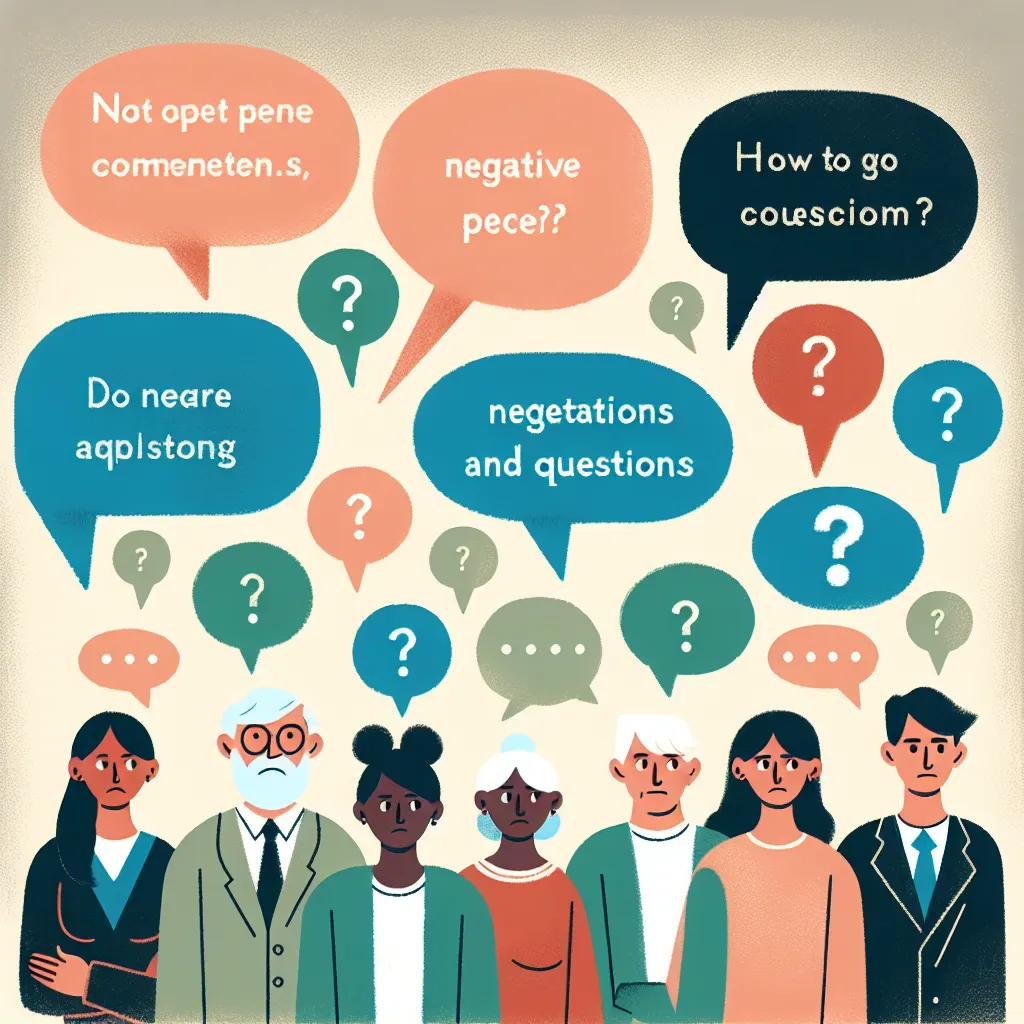Are you struggling with forming negative sentences and asking questions in English? You’re not alone! Many English learners find these aspects challenging, but with the right strategies, you can master them. In this article, we’ll explore 10 effective tips to help you improve your skills in English negations and questions, making your language more natural and fluent.
Why Are Negations and Questions Important in English?
Before diving into our tips, let’s understand why mastering negations and questions is crucial for English proficiency. These language structures are fundamental for effective communication, allowing you to express disagreement, seek information, and engage in meaningful conversations. Without them, your ability to interact in English would be severely limited.
 English negations and questions importance
English negations and questions importance
1. Understand the Basic Structure of Negations
To form negations in English, you typically add “not” after the auxiliary verb or use contractions like “don’t,” “isn’t,” or “haven’t.” For example:
- Positive: She is happy.
- Negative: She is not happy. (Or: She isn’t happy.)
Remember that in simple present and simple past tenses with most verbs, you need to use “do/does/did” + “not” to form negatives:
- I play tennis. → I do not play tennis. (Or: I don’t play tennis.)
- He went to the store. → He did not go to the store. (Or: He didn’t go to the store.)
2. Master Question Formation
English questions generally follow this structure: Question word (if applicable) + Auxiliary verb + Subject + Main verb. For example:
- Where do you live?
- Is she coming to the party?
For simple present and past tenses, remember to use “do/does/did” in questions:
- Do you like coffee?
- Did they finish their homework?
3. Practice with Yes/No Questions
Yes/No questions are a great starting point for mastering question formation. They typically begin with an auxiliary verb (is, are, do, does, have, etc.) followed by the subject and main verb. For instance:
- Are you ready?
- Do they live in London?
- Have you finished your meal?
4. Use Question Words Effectively
Familiarize yourself with question words (who, what, where, when, why, how) and practice using them to form more complex questions:
- Who is your favorite author?
- What time does the movie start?
- Where did you go on vacation?
 Question words in English
Question words in English
5. Learn Negative Question Structures
Negative questions can express surprise, disappointment, or seek confirmation. They’re formed by placing “not” after the subject or using contractions:
- Isn’t she coming to the party?
- Don’t you like chocolate?
Pay attention to the slight change in meaning these questions can convey compared to their positive counterparts.
6. Practice Tag Questions
Tag questions are short questions added to the end of statements. They can be tricky but are common in conversational English:
- You’re coming to the party, aren’t you?
- She doesn’t like coffee, does she?
The rule of thumb is to use a positive tag for a negative statement and vice versa.
7. Use Negations in Different Tenses
Practice forming negations in various tenses to build your confidence:
- Present Perfect: I haven’t seen that movie.
- Past Continuous: They weren’t studying when I called.
- Future: We won’t be able to attend the meeting.
8. Understand Double Negatives
In standard English, double negatives are generally avoided. Instead of reinforcing a negative, they often create a positive meaning:
- Incorrect: I don’t have no money.
- Correct: I don’t have any money. (Or: I have no money.)
9. Learn Idiomatic Negative Expressions
English has many idiomatic expressions involving negations. Learning these can make your language more natural:
- Not at all
- Nothing to write home about
- No way
For example: “The movie was nothing to write home about” means it wasn’t particularly good or interesting.
10. Practice, Practice, Practice!
The key to mastering English negations and questions is consistent practice. Here are some ways to incorporate practice into your daily routine:
- Write a journal entry each day using at least three negative sentences and three questions.
- Have conversations with native speakers or language exchange partners, focusing on asking questions and using negations.
- Watch English movies or TV shows and pay attention to how characters form questions and use negatives.
- Use language learning apps that offer exercises specifically for negations and questions.
Important Considerations
When working on your negations and questions, keep these points in mind:
- Intonation matters, especially in questions. Practice rising intonation for yes/no questions and falling intonation for wh-questions.
- Be aware of formal vs. informal usage. For example, “Do you not like coffee?” is more formal than “Don’t you like coffee?”
- Remember that some verbs (like “be” and modal verbs) don’t require “do” for negations or questions.
Next Steps
Now that you have these tips, it’s time to put them into practice! Start by identifying areas where you struggle most with negations and questions. Then, create a study plan focusing on those areas. Set achievable goals, such as mastering one new question structure each week or using five new negative expressions in conversation.
Remember, becoming proficient in English negations and questions takes time and effort, but with consistent practice and these helpful tips, you’ll see improvement in no time. Don’t hesitate to seek feedback from teachers or language partners to refine your skills further.
Keep challenging yourself, and soon you’ll be forming negations and asking questions with confidence and ease!




